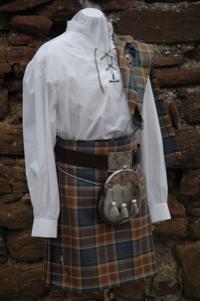|
The Isle of Man KiltAlthough there are several differing theories as to when the Celts first arrived on the island (the facts never having being documented) the most probable is that they arrived around 600 BC.
Isle of Man National Tartan So the Island probably has as long a Celtic history as Scotland, Ireland, Wales, Cornwall and other parts of Southern England. The wearing of tartan on the island it would seem however, did not survive as well as in other Celtic strongholds. The revival of the Isle of Man Kilt took place around 1940. There are eleven District Tartans for the island, plus two others which are the most popular and widely sold. These are the National Tartan, which is described as follows, it incorporates the blue for the see, green for the hills, gold for the gorse, purple for the heather and white for the cottages. And the Hunting Tartan which incorporates the following colours, Dark Grey, Grey Green, Clear Blue, Grey Blue, Bright Gold and Pure White As you can see from the photos, the full
kilt outfit
bares a striking resemblance to its Scottish counterpart.
Isle of Man Hunting Tartan And as with the Irish tartans, the Isle of Man Tartans are mostly woven in Scotland where the traditional weaving skills are being kept very much alive, as is the Celtic heritage. The kilts themselves however are hand made on the island, using all the traditional kilt making skills which have been handed down from generation to generation. The popularity of the kilt and all its accessories continues to grow year on year,and the Island's Kilts are being worn with great pride. If you would like more information on these particular kilts, then please visit Manninkilt a company who specialize in these particular tartans and whom I highly recommend. It is my intention to bring as much information on this and all other related subjects as is possible, and to keep it current and up to date. This web-site therefor will continue to grow as I delve further into the origins and history of the kilt, in all its different locations around the world. Return from isle of Man Kilt to Kilts Page |





